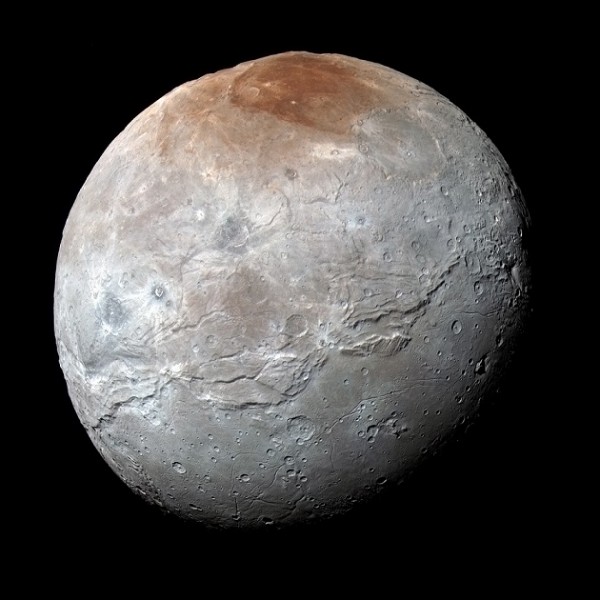By Ana Verayo, | March 20, 2016

Charon in Enhanced Color NASA's New Horizons captured this high-resolution enhanced color view of Charon just before closest approach on July 14, 2015.
The most mysterious former planet in the solar system is slowly unraveling its secrets as Pluto's largest moon Charon also possesses unique features unlike the other four smaller satellites of the system.
Scientists led by Mark Showalter from the SETI (Search for ExtraTerrestrial Intelligence) Institute revealed that the other smaller moons of Pluto namely, Nix, Styx, Hydra and Kerberos are believed to form after a violent collision that followed the same impact that formed Pluto's largest moon, Charon. Since these moons all originate from the same impact, they are also expected to be made from similar elements and properties.
Like Us on Facebook
However, Showalter revealed that the surfaces of the smaller moons appear to be much brighter and rather more ancient than Charon. Apart from different surface textures and appearances, these smaller moons also posses rather odd rotations where they orbit tilting sideways on their axis, even if there is a strong presence of gravitational forces from Pluto.
Using data and high resolution images obtained from NASA's New Horizons spacecraft that was collected from last July during its closest approach, the team believes that these collisions are what shaped the smaller moons of Pluto, causing these odd rotations.
SETI researchers published five separate studies about Pluto and its moons where they revealed a wealth of scientific information about Pluto's largest moon such as new found evidence of ammonia ice on the surface.
Apart from this discovery the northern polar regions of Charon reveals a complex terrain filled with frozen water and icy features that shows a distinct reddish hue. Scientists suggest that this rather odd coloration is caused by tholin, which is a molecule that is produced from irradiation of compounds such as methane. Scientists also discovered how the overall surface of Charon is older and more consistent, and less geologically active than Pluto.
New Horizons data also revealed that Pluto's Sputnik Planum icy plains that span more than 1000 kilometers wide are filled with volatile nitrogen and carbon monoxide ice, resulting in a relatively smooth appearance of the plains that could also hint at geologic activity. There are also mysterious features that look like depressions that could also indicate ice volcanoes, namely Wright Mons and Piccard Mons, but further analyses are needed to confirm these, according to senior scientist Ross Beyer of SETI Institute.
According to SETI Institute scientist David Hinson, Pluto's atmosphere also possesses a multi layered haze from the surface to 200 kilometers in altitude, where the upper atmosphere is colder and the lower atmosphere's temperatures vary for each location. These studies are published in the journal, Science.
-
Use of Coronavirus Pandemic Drones Raises Privacy Concerns: Drones Spread Fear, Local Officials Say

-
Coronavirus Hampers The Delivery Of Lockheed Martin F-35 Stealth Fighters For 2020

-
Instagram Speeds Up Plans to Add Account Memorialization Feature Due to COVID-19 Deaths

-
NASA: Perseverance Plans to Bring 'Mars Rock' to Earth in 2031

-
600 Dead And 3,000 In The Hospital as Iranians Believed Drinking High-Concentrations of Alcohol Can Cure The Coronavirus

-
600 Dead And 3,000 In The Hospital as Iranians Believed Drinking High-Concentrations of Alcohol Can Cure The Coronavirus

-
COVID-19: Doctors, Nurses Use Virtual Reality to Learn New Skills in Treating Coronavirus Patients







